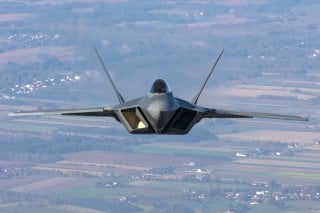Why Israel Wants the F-22 Raptor (And Why It Won't Get It)
As the world’s first-ever fifth-generation jet, the Raptor is a fan favorite among military experts and aviation buffs. The stealth technology incorporated in the platform is so cutting-edge that the United States has prohibited its export in order to safeguard its components.
Considering Israel’s proximity to hostile neighbors, it is fair to assume the nation has more wants than needs when it comes to arms. From air defense systems and fighter jets to main battle tanks and surface-to-air missiles, the Jewish state already possesses the most dominant military in the Middle East. While Israel’s fleet is well-stocked with some of the most advanced U.S.-made platforms available, including specialized variants of the F-15, F-16 and F-35, there is one formidable fighter the Jewish state will never be able to fly. The F-22 Raptor arguably remains one of the most superior jets to ever fly the skies despite its service age. As the world’s first-ever fifth-generation jet, the Raptor is a fan favorite among military experts and aviation buffs. The stealth technology incorporated in the platform is so cutting-edge that the United States has prohibited its export in order to safeguard its components.
Specs and capabilities
The Lockheed Martin F-22 Raptor was crafted during the height of the Cold War in the 1980s. Designed to combine the abilities of an air superiority fighter with ground attack, signal intelligence, and electronic warfare capabilities, the platform was largely a result of the U.S. Air Force’s Advanced Tactical Fighter program. Perhaps the fighter’s most significant attribute is its small radar cross-section. This feature, coupled with the jet’s twin thrust-vectoring F119 turbofan engines, enables the fighter to outperform all other fifth-generation near-peers in the skies while remaining undetectable.
In terms of armaments, the F-22 is well-equipped. The jet’s larger frame allows for three internal weapons bays that can carry an array of lethal weaponry when in a stealth configuration. Notably, the jet can lug two Aim-9 Sidewinder air-to-air missiles and six Aim-120 AMRAAM radar-guided air-to-air missiles in its side weapons bay at the same time, while carrying two AIM-120 AMRAAM and two GBU-32 JDAM bombs in its center weapons bay.
As stated by the Air Force, “The F-22’s characteristics provide a synergistic effect ensuring F-22A lethality against all advanced air threats. The combination of stealth, integrated avionics, and supercruise drastically shrinks surface-to-air missile engagement envelopes and minimizes enemy capabilities to track and engage the F-22. The combination of reduced observability and supercruise accentuates the advantage of surprise in a tactical environment.”
Why exporting the Raptor won’t be easy
Considering the Raptor’s prowess, it makes sense that Israel and the rest of the international community would be ecstatic to fly the platform. However, U.S. legislation ensures that the F-22 (and its technology) will never reach the hands of American adversaries or allies. In the early 1990s, Congress voted to explicitly prohibit the sale of the Raptor, stating that “None of the funds made available in this Act may be used to approve or license the sale of F-22 advanced tactical fighters to any foreign government.” While several previous U.S. presidents have looked at the possibility of F-22 exports, the Raptors have never been fully approved for international sales. The threat of these lethal airframes getting into Russian, Iranian, or Chinese hands was not worth the risk.
About the Author: Maya Carlin
Maya Carlin, National Security Writer with The National Interest, is an analyst with the Center for Security Policy and a former Anna Sobol Levy Fellow at IDC Herzliya in Israel. She has by-lines in many publications, including The National Interest, Jerusalem Post, and Times of Israel. You can follow her on Twitter: @MayaCarlin. Carlin has over 1,000 articles published over the last several years on various defense issues.
Image: Shutterstock.

